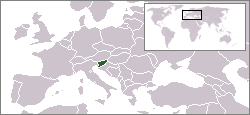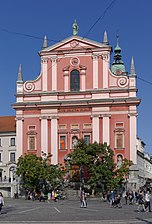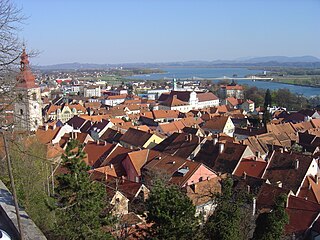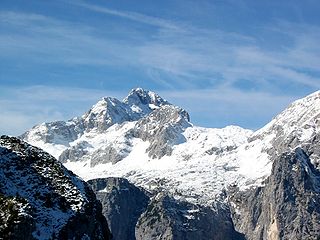| location | |
 | |
| flag | |
 | |
| Short dates | |
| Capital | Ljubljana |
|---|---|
| Form of government | Parliamentary republic |
| currency | Euro (€) |
| surface | 20,300 km² |
| population | 2.01 million (Slovenes 92%, Serbo-Croatians 6.2%, others 1.8%) |
| languages | Slovenian, in the minority areas too Italian and Hungarian |
| Religions | Roman Catholic (Uniert 2%) 70.8%, Lutheran 1%, Muslim 5% |
| power grid | 230 V / 50 Hz |
| Phone code | 386 |
| Internet TLD | .si |
| Time zone | ME (S) Z |
Slovenia located in Southern Europe and extends between the Eastern Alps and the northeast Adriatic. Bordering countries are Italy, Austria, Hungary and Croatia. Slovenia was the first country of the former multi-ethnic Yugoslavia to join the EU.
Despite its small size, the country has a surprising variety of landscapes, from the Adriatic beaches to the peaks of the Julian Alps. The German state of Rhineland-Palatinate is roughly the same size, but has twice as many inhabitants.
Regions
Slovenia can be divided into four different landscapes. In the northwest are the high mountain ranges of the Julian Alps, Karawanken and Steiner Alps. The southwest near the Adriatic Sea is a Mediterranean landscape. The karst areas begin in the south, some of which are assigned to the Istrian peninsula. In the east, near the Hungarian border, the country merges into the Pannonian Plain.
Slovenia consists of:
- 58% forest area
- 36% nature reserve Natura 2000
- 9,023 karst caves
- 20% of the coast is a nature reserve
- 27,000 km of flowing water
Slovenia is divided into 12 statistical and tourism regions:
- region Gorenjska - in the Julian Alps and on the Karavanke ridge in the north
- region Goriška - in the west on the border with Italy in the Julian Alps
- Southeast Slovenia - in the southeast on the border with Croatia
- Koroška - the Slovenian Carinthia, on the border with Austria
| Map of Slovenia |
- region Notranjsko-kraška Region - in the south on the border with Croatia
- region Obalno-kraška - Adriatic coast and karst region, between the borders with Italy and Croatia
- Central Slovenia - the central region with the capital Ljubljana
- region Podravska - in the east with borders with Austria and Croatia
- region Pomurska - in the far east with borders with Austria, Croatia and Hungary
- region Savinjska - in the eastern center, from the border with Austria to the border with Croatia
- region Spodnjeposavska - in the central south, on the lower reaches of the longest Slovenian river, the Sava
- region Zasavska - the smallest of the Slovenian regions, centrally located
Cities
- 6 Piran
 . one of the most beautiful coastal cities in Slovenia, located on a promontory jutting out into the Mediterranean.
. one of the most beautiful coastal cities in Slovenia, located on a promontory jutting out into the Mediterranean.

The Franciscan Church in Ljubljana
The old town of Piran

Predjamski grad in Postojna
The city castle of Maribor
Other goals


- 1 Lipica Stud (Kobilarna Lipica). in the municipality of Sežana, the district Lipica is the namesake for the white Lipizzaner horses.
- Bohinj - with the elongated lake, is one of the most scenic areas of the Slovenian Alps.
- 9 Bovec
- 3 Skocjan stalactite caves (Škocjanske jame). In contrast to the much better known Postojna Caves, these have been added to the UNESCO World Heritage List.

- 4 Raab-Őrség-Goricko Nature Park (Krajinskegi park Raab-Őrség-Goričko). (Slovenia, Austria, Hungary).
- Amber Road (Jantarna cesta)
background
getting there

EU and EEA citizens as well as Swiss nationals require an identity card / identity card or passport for a stay of up to three months when entering Slovenia. A residence permit is required for longer stays, and children must be entered in a parent's passport or have a child ID card.
By plane
The main airport in Slovenia is Ljubljana Airport. There are direct flights to Ljubljana e.g. from Frankfurt am Main, Munich, Vienna and Zurich and other European metropolises.
There are also two smaller airports in Maribor and Portorož.
By train
From Zurich, Vienna and Munich there are direct connections to Ljubljana (Ljubljana). From Frankfurt am Main there are through coaches to Ljubljana (Laibach) via Stuttgart. Otherwise you may have to change trains in Salzburg or Villach.
By bus
Most European bus connections go to Ljubljana. But there are also individual connections to Maribor (Marburg) or other cities in Slovenia.
In the street
Speed limits
50 km / h - localities 110 km / h - expressways 90 km / h - regional roads 130 km / h - motorways
In Slovenia exists on the motorways since July 1st, 2008 Vignette compulsory for vehicles with a gross vehicle weight of max. 3.5 t, with any trailer. There are still 27 toll stations for motorhomes over 3.5 tons and trucks, where a route-dependent road toll has to be paid. Cars and motorcycles can slowly drive through these toll stations on the special lanes with the vignette sign. Further information is available from ÖAMTC
2020 Slovenia vignette prices:[outdated]
- Category 1: Single-track motorcycle.
- Annual motorcycle vignette: 55 euros
- 6-month motorcycle vignette: 30 euros
- 7-day motorcycle vignette: 7.50 euros
- Category 2A: Cars (including SUVs, pickups, mobile homes, etc.) with a gross vehicle weight of up to 3.5 tons.
- Annual vignette car 2A: 110 euros
- 1-month vignette for cars 2A: 30 euros
- 7-day vignette for cars 2A: 15 euros
- Category 2B (new since 2014): Cars if the height of the vehicle up to 3.5 tonnes gross vehicle weight, measured precisely on the front axle, exceeds 1.30 m. These are mainly vans, large vans and delivery vans. It does not mean the maximum height of the vehicle. Category 2A always applies to mobile homes up to 3.5 t.
- Annual vignette car 2B: EUR 220
- 1-month vignette for cars 2B: 60 euros
- 7-day vignette car 2B: 30 euros
Annual vignettes are always valid from December 1st of the previous year to January 31st of the following year.
The proof of purchase or the Carry the invoice for the vignette with youto prove the validity and purchase of the vignette.
Note: For a weekly vacation from Friday to Friday, for example, two 7-day vignettes or one 1-month vignette are required, as the period from Friday to Friday is already 8 calendar days.
The date of sale must match the date of the punching, it must not be punched to a future date. The only exception is the 7-day vignette. These can be punched for a future date when purchasing. There may be controls, so you should always have the proof of purchase with you.
Coming from Germany, western Austria and eastern Switzerland, the journey via the Tauern and Katschberg tunnels and then via the Karawanken tunnel is usually the fastest option. For this you have to drive towards Ljubljana at the Villach motorway junction. There is a toll of 9.50 euros for the Tauern and Katschberg tunnels, and 6.50 euros for the Karawanken tunnel. If you want to save yourself this Karawanken toll, you can also drive over the Wurzenpass. At the Villach junction, head towards Italy and take the Villach-Warmbad exit and follow the signs for the Wurzenpass / Kranjska Gora. We continue to Kranj or to Bovec via Vršič pass (not suitable for caravans) to About-Valley.
If you are coming from Eastern Austria, you will need to travel via Graz Maribor (Marburg) to be recommended.
If you come from western, central Switzerland or Ticino, you can drive towards Italy via the Simplon or Gotthard tunnel. There it goes to Slovenia via Milan and Trieste.
You have to go to Slovenia too dipped headlights during the day switch on, you should have a set of spare lamps with you. In winter all winter tires must have a tread depth of at least 4 mm or summer tires at least 4 mm and snow chains in the trunk. But if you hinder traffic with bad tires, the penalty is very high. The alcohol limit is 0.5. When reversing, you have to turn on the hazard warning lights (even if many Slovenes don't even know it themselves).
It is compulsory to put on a safety vest if you leave your car after an accident or breakdown on motorways or expressways. There is a risk of fines starting at 40 euros. There is no obligation to carry safety vests with you. Motorcyclists are exempt from the mandatory safety vest.
By boat
Arrival by ship is only possible at certain times from Venice from possible.

mobility
Slovenia has a well-developed rail and bus network. The roads are also in excellent condition; there are no scheduled flights in Slovenia due to the small size of the country.
A well-known cycling route is the Parenzana (D-8), which runs along the coast and connects Italy with Croatia. Another is that Drava cycle pathwho comes from Austria. There is no obligation to wear a helmet. Drivers are predominantly considerate at intersections. Bike paths are also used by mopeds, which often go very fast. There are still some country roads made of gravel.
language

In Slovenia will Slovenian spoken. As a tourist you can also come along English good progress and especially in the respective border areas is also often German or Italian spoken. German is also increasingly spoken in the larger cities of Maribor and Ljubljana. The Trieste border area (with places like Portorož and Izola) is signposted in two languages (Slovenian and Italian).
to buy
Slovenia opened on January 1, 2007 Euro introduced the previous currency Tolar replaced.
It is practical to withdraw money from ATMs with your EC or Maestro card or Postfinance card (Switzerland). Major credit cards are also mostly accepted in Slovenia.
The value added tax or "Dodano vrednost" (DDV) is 22% or 9.5%. The prices in retail are a little cheaper than in expensive Austria. The German discounter Hofer and Lidl have branches here. The rather small shops of the Mercator chain can be found almost everywhere.
Pumpkin seed oil is worth buying in Slovenia. It has at least the same quality as in Styria, but is much cheaper here (around 14 to 16 per liter in 2008). When buying one must be careful to buy 100%, there are also many dilutions on the market.
kitchen


Detailed information on Slovenian cuisine as a whole can be found in a separate topic article Food and drink in Slovenia.
Slovenian cuisine is heavily influenced by Austrian cuisine (and vice versa). Influences from the time in Yugoslavia are also present. Dishes like burek or cevapcici can be found here. Of course, fresh fish is also served on the coast. As in many European countries, international cuisine has also found its way into Slovenia. There is hardly a city in which you cannot find a pizzeria. In the south on the Adriatic coast there are many variations of fresh fish.
Unusual things also find their way onto the menu in Slovenia. So it can happen that you find bear on the map. Vegetarians will hardly have any problems in Slovenia. There's always something on the menu, and if that's not the case, you're usually more than happy to prepare a meat-free meal.
Most restaurants try to offer multilingual menus.
Pumpkin seed oil is the highlight of Slovenian cuisine. Like in the Styria hardly a salad can do without it. The aroma is uniquely nutty. You shouldn't leave Slovenia without trying it. The nutty aroma of the dark oil (in Carinthia it is called Wagenschmiere) is unsurpassed. Pumpkin seed oil is not only suitable for heating, but there are enough uses for cold dishes.
Another Slovenian specialty is the herbal liqueur "Pelinkovac" from Petovia Ptuj. It has about 25% alcohol and an unusual but pleasant aroma.
Extensive information about Slovenian cuisine can be found at Culinary Travel to Slovenia and Carinthia, from Gorenjska to Prekmurje.
nightlife
The centers of night life are of course the larger cities Ljubljana (Laibach) and Maribor (Marburg). In the smaller towns of Slovenia it is rather calm.
accommodation
Basically there is accommodation for every budget in Slovenia. However, some are not open all year round. This applies above all to campsites, but also to some youth hostels (during the summer semester break, many student residences are operated like normal youth hostels). The price differences between comparable accommodations are often considerable, and it is particularly important to take a closer look when booking.
The large international corporations (such as Accor, Melia, Navarra, etc.) are less present in the hotels. If the hotel belongs to a chain, then the chain is rather small and little known. As a consequence, the Slovenian hotels are usually a bit more individual.
There is often a tourist tax / sojourn tax.
Learn
Slovene courses are offered in the larger cities. The main university is in Ljubljana.
Work
It is possible for EU citizens and Swiss citizens (free movement of persons agreement) to work in Slovenia.
public holidays
| Next appointment | Surname | importance |
|---|---|---|
| Saturday 1st January 2022 | Novo leto | New Year |
| Tuesday, February 8, 2022 | Prešernov dan, slovenski kulturni praznik | Prešeren Day, Slovenian cultural holiday (Anniversary of the death of the national poet France Prešeren) |
| Monday April 18, 2022 | Velika noč | Easter Monday |
| Tuesday, April 27, 2021 | Dan upora proti okupatorju | Day of Resistance against Nazi Occupation (1941) |
| Saturday 1st May 2021 until Sunday, May 2, 2021 | Praznik dela | Labor Day |
| Friday June 25th 2021 | Dan državnosti | Statehood Day |
| Sunday 15th August 2021 | Marijino vnebovzetje | Assumption Day |
| Sunday 31st October 2021 | Dan reformacije | Reformation Day (1517; in memory of the Slovenian reformer Primož Trubar) |
| Monday 1st November 2021 | Dan spomina na mrtve | All Saints 'Day (actually All Souls' Day, literally: Remembrance Day) |
| Saturday 25 December 2021 | Božič | Christmas Day |
| Sunday, December 26th, 2021 | Dan samostojnosti in enotnosti | Independence and Unity Day (Announcement of the outcome of the independence referendum in Parliament in 1991) |
security
Slovenia is a very safe country to travel to. Of course, theft can occasionally also occur in Slovenia. However, normal precautionary measures are usually sufficient. You shouldn't leave valuables in your car or leave them unattended on the beach. The phone number for the police in Slovenia is 113.
health
The Slovenian health system is based on Western European standards. You will have no problems finding a competent doctor. The hygienic conditions in Slovenia are also absolutely ok.
You just have to beware of strong sunlight. In the mountains in particular, it is easy to underestimate the sun. You have to watch out for sea urchins in the sea. These are very common and stepping on a sea urchin can be very painful.
climate
Although Slovenia is a small country, three types of climate can be distinguished in the relatively narrow space. Most of the country is influenced by the Central European climate with moderate temperatures and constant rainfall throughout the year. In the eastern part of the country, the internal situation in the continent becomes noticeable through an increase in the temperature amplitude (phenomenon of continentality). In the north of Slovenia and in the area that is part of the Alps, there is an alpine or sub-alpine climate. This means that in winter it can get very cold due to the higher location, but in summer it does not reach extremely hot temperatures. The third type of climate in Slovenia is the so-called Mediterranean or sub-Mediterranean climate, which can be found directly on the Adriatic coast and its hinterland. The region around Nova Gorica up to the Soča valley is also influenced by the sub-Mediterranean climate. Here the summers are very warm and the winters mild. However, the rare ingress of cold air ensures that the evergreen plants that are so typical of Mediterranean regions only grow to a limited extent here.
respect
There are no special rules of conduct in Slovenia. In general, they do not differ from those in German-speaking countries.
Post and Telecommunications
Pošta Slovenije d. o. o. (German: Slovenian Post GmbH) is the state-owned postal company in Slovenia, based in Maribor. With almost 6,000 employees, the company is one of the largest employers in Slovenia. With equity of € 221,527,487 (2013), the equity ratio is around 78.7%. In 2013, the Slovenian Post had 560 offices with 1,144 counters. The public network comprises 556 post offices (of which 331 delivery post offices, 168 non-delivery post offices, 28 franchise post offices, 24 mobile post offices, a temporary post office and four post offices), two mail sorting and logistics centers and a post office for reloading parcels.
The Telekom Slovenije, d. d. is a telecommunications company in Slovenia. The company is based in Ljubljana and has been listed as a stock corporation on the Ljubljanska borza since October 2, 2006. The Telekom Slovenije Group is present in several countries in Southeast Europe and Gibraltar.
literature
The Slovenian literature is the literature written in the Slovenian language. It starts with the Freising monuments (Brižinski spomeniki) around the year 1000. The first books in Slovenian were printed around 1550.
Significant representatives of Slovenian literature are France Prešeren (1800–1849) and Ivan Cankar (1876-1918).
Web links
- https://www.gov.si/en/ (en) - Official website of Slovenia
- Speed limits in Slovenia
- Official website of the Slovenian government
- www.slovenia.info/de

_-_colored.svg/300px-Slovenia,_administrative_divisions_-_de_(statistical_regions)_-_colored.svg.png)


















.jpg/350px-Portoroz_(3956393456).jpg)


